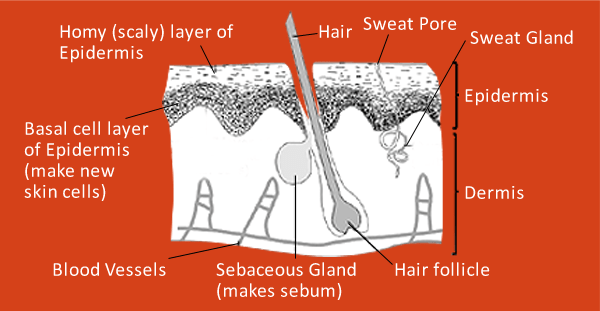Our skin
The skin has many important functions:
-
Skin is the largest organ in our body
-
It protects us from injury
-
It cools us when we get hot through sweating
-
It prevents us from becoming dehydrated
The skin has two main layers:
The epidermis
The epidermis is the top or outer layer. It contains two main types of cell: squamous cells and melanocytes.
The dermis
The melanocytes in the dermis produce melanin, the substance that gives skin its colour (pigment). When the skin is exposed to sunlight it gets darker because the melanocytes produce more melanin.
Skin cancer
Basal cell carcinoma (BCC)
-
BCC is the most common form of skin cancer, making up 60% of all skin cancers in Hong Kong.
-
It usually occurs in people over 40 years of age, but it can also develop in younger people.
-
Most BCCs develop on areas frequently exposed to the sun, such as the head, neck and upper body. Some appear on the arms and legs.
-
BCCs can be red, pale or pearl-like in colour.
-
They tend to grow slowly and don't spread to other parts of the body, but if left untreated BCCs can grow deeper into the skin and damage the nearby tissue. This may make treatment more difficult and increase the chance of skin cancer returning.

Squamous cell carcinoma (SCC)
-
SCCs are less common and account for about 30% of skin cancer cases in Hong Kong. They occur mostly in people over 50 and usually appear on the head, neck, hands and forearms. Less often they can also develop on the upper body or the legs.
-
SCCs may appear as thickened, red, scaly spots which may later bleed easily or feel tender to touch. SCCs tend to grow quickly over several months and can spread to other parts of the body. SCCs on the lips or ears have a high risk of spreading and should be seen by a doctor immediately.
Melanoma
-
Melanoma is the least common skin cancer, but it is the most serious. Melanomas account for about 10% of skin cancer cases in Hong Kong. They can be treated successfully when diagnosed early.
-
The first sign of melanoma is usually the appearance of a new spot, or a change in an existing freckle or mole. The change may be in size, shape or colour and is normally noticed over several weeks or months.
-
Melanomas often have an irregular edge or surface.

Helpline
Tel: (852) 3656 0800
Donation Hotline
General donation:(852) 3667 6333
COF Monthly donation:(852) 3667 6332 
- Questions or comments: please use our comments page
- Donation enquiries: [email protected]
- Media enquiries: [email protected]
- Fundraising enquiries: see Get Involved



